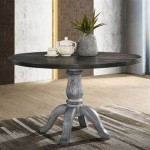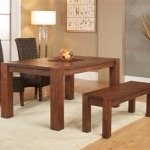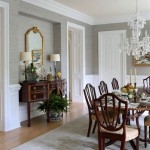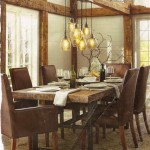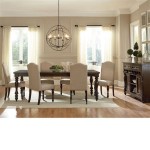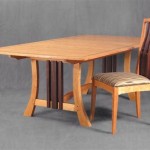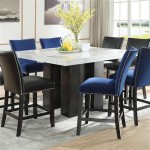What To Put On Walls In The Dining Room: A Comprehensive Guide
The dining room serves as a space for nourishment, conversation, and connection. Its aesthetic appeal significantly impacts the atmosphere, influencing the enjoyment of meals and the overall experience of gatherings. Decorating the walls is a crucial aspect of crafting this ambiance, and careful consideration should be given to the elements chosen to adorn them. Selecting the right wall decor involves a nuanced understanding of color palettes, artwork styles, functional considerations, and the prevailing architectural style of the room.
This article will delve into various options for decorating the dining room walls, focusing on aesthetic considerations, practicality, and the harmonious integration of wall decor with existing furnishings and design themes. The aim is to provide a thorough guide to help individuals make informed decisions that transform their dining rooms into visually appealing and welcoming spaces.
1. Artwork Selection: Paintings, Prints, and Photography
Artwork stands as a classic and versatile choice for dining room wall decor. Paintings, prints, and photography offer an extensive range of styles, subjects, and sizes, allowing for a personalized expression of taste and aesthetic preferences. The selection process should consider the existing color scheme of the dining room, the style of the furniture, and the overall desired mood.
For a formal dining room with traditional furnishings, consider classic landscape paintings, still life arrangements, or portraiture. Opt for pieces with rich colors, ornate frames, and a sense of timeless elegance. These types of artwork tend to enhance the sophistication and grandeur of the space.
Modern and contemporary dining rooms benefit from abstract paintings, geometric prints, or minimalist photography. These options complement clean lines, simple forms, and bold color palettes. Black and white photography, particularly architectural or nature-based images, can introduce a touch of sophistication without overwhelming the space.
When selecting artwork, pay attention to the scale and proportion of the pieces in relation to the wall space. A large, statement piece can serve as a focal point, while a collection of smaller pieces arranged in a gallery wall format can create visual interest and depth. Ensure that the artwork is hung at eye level for optimal viewing.
Furthermore, consider the themes and subject matter of the artwork. Food-related art, such as depictions of fruits, vegetables, or culinary scenes, can be particularly appropriate for a dining room. However, avoid overly distracting or controversial imagery that might detract from the dining experience or spark unwanted discussions.
The framing of the artwork also merits attention. Choose frames that complement both the artwork itself and the overall decor of the room. Metal frames offer a sleek and modern look, while wood frames provide a more traditional and warmer feel. Consider using frames with matting to enhance the presentation and protect the artwork.
2. Mirrors: Enhancing Light and Space
Mirrors serve not only as decorative elements but also as functional tools for enhancing light and space in the dining room. Strategically placed mirrors can reflect natural light, making the room appear brighter and more spacious. They also create visual depth, particularly in smaller dining rooms.
A large, decorative mirror placed on a prominent wall can act as a focal point, drawing the eye and creating a sense of grandeur. Opt for mirrors with ornate frames for a traditional aesthetic or simple, frameless mirrors for a more modern look. Consider the shape of the mirror in relation to the room's proportions. Rectangular mirrors work well in elongated spaces, while round or oval mirrors can soften the lines of a more angular room.
A gallery wall of smaller mirrors offers a more eclectic and dynamic approach. Choose mirrors of varying shapes, sizes, and frame styles to create an interesting visual composition. This approach works particularly well in informal dining rooms or those with a bohemian or eclectic theme.
When positioning mirrors, consider what they will reflect. Ensure that the reflection is visually appealing and enhances the overall aesthetic of the room. Avoid placing mirrors in locations where they will reflect clutter or unflattering views.
Mirrors can also be incorporated into other decorative elements, such as mirrored furniture or decorative trays. These elements can further enhance the reflective properties of the room and create a sense of cohesiveness.
The use of antique or vintage mirrors can add character and charm to the dining room. These mirrors often feature unique details and imperfections that contribute to their individual appeal. However, be mindful of the condition of antique mirrors, as some may have significant wear or damage.
3. Wallpapers and Wallcoverings: Texture and Pattern
Wallpapers and wallcoverings offer a multitude of options for adding texture, pattern, and color to the dining room walls. From subtle textures to bold prints, wallpapers can transform the atmosphere of the space and create a unique visual statement.
When selecting wallpaper, consider the size of the room, the amount of natural light, and the existing furniture. In smaller dining rooms, opt for lighter colors and smaller patterns to avoid overwhelming the space. In larger dining rooms, bolder colors and larger patterns can be used to create a more dramatic effect.
Textured wallpapers, such as grasscloth or textured vinyl, can add depth and dimension to the walls. These options work well in minimalist or contemporary dining rooms, where the focus is on subtle details and tactile appeal.
Patterned wallpapers offer an endless array of design possibilities. Floral patterns, geometric patterns, and abstract patterns can all be used to create different moods and styles. Consider the scale of the pattern in relation to the size of the room and the style of the furniture.
For a formal dining room, consider using damask or brocade wallpapers. These luxurious options evoke a sense of elegance and sophistication. For a more casual dining room, consider using striped or patterned wallpapers with a more relaxed feel.
Wall murals offer a bold and dramatic option for creating a focal point in the dining room. These large-scale images can depict landscapes, cityscapes, or abstract designs. Wall murals are best suited for larger dining rooms with ample wall space.
The installation of wallpaper requires careful preparation and precise execution. Ensure that the walls are properly prepared and primed before applying the wallpaper. Consider hiring a professional installer for best results.
4. Decorative Plates and Ceramics: A Culinary Aesthetic
Decorative plates and ceramics provide a unique and visually interesting way to adorn dining room walls. This option not only adds a touch of personality but also complements the function of the room as a space for dining and culinary enjoyment.
Consider curating a collection of plates with varying designs, colors, and textures. These can be antique plates, vintage finds, or contemporary ceramics. Mixing and matching different styles can create an eclectic and personalized display.
Arrange the plates in a visually appealing pattern on the wall. Consider using plate hangers or adhesive discs specifically designed for hanging plates. Ensure that the plates are securely attached to the wall to prevent them from falling.
The color scheme of the plates should complement the overall color palette of the dining room. Consider using plates with similar colors or patterns to create a cohesive look. Alternatively, you can use plates with contrasting colors to create a more dramatic effect.
Decorative ceramics, such as vases, bowls, or figurines, can also be incorporated into the wall display. These elements can add depth and dimension to the overall composition.
Consider the placement of the plate display in relation to the furniture and other decorative elements in the room. The display should be visually balanced and harmonious with the surrounding decor.
This decorative approach can also be extended to include other culinary-themed items, such as vintage kitchen utensils or antique serving dishes. These elements can further enhance the culinary aesthetic of the dining room.
5. Shelving and Wall-Mounted Cabinets: Functional Decor
Shelving and wall-mounted cabinets offer a practical and stylish way to decorate the dining room walls. These options provide storage space while also serving as display areas for decorative objects, books, and other personal items.
Choose shelving units that complement the style of the dining room furniture. Sleek, modern shelves work well in contemporary spaces, while ornate, wooden shelves are better suited for traditional dining rooms.
Wall-mounted cabinets provide enclosed storage space for dinnerware, glassware, and other dining essentials. Opt for cabinets with glass doors to display cherished items while keeping them protected from dust.
Arrange decorative objects on the shelves in a visually appealing manner. Consider using a mix of sizes, shapes, and textures to create an interesting composition. Include items such as vases, candles, picture frames, and books.
The color scheme of the shelves and cabinets should complement the overall color palette of the dining room. Consider painting the shelves a contrasting color to create a focal point.
Ensure that the shelves and cabinets are securely mounted to the wall to prevent them from falling. Consider using professional installation services for best results.
These elements can be particularly useful in smaller dining rooms where space is limited. They provide valuable storage space without taking up floor space.
Incorporating plants and greenery into the shelving display can add a touch of freshness and vibrancy to the dining room.
Selecting the appropriate wall decor for the dining room requires a thoughtful approach, considering the room's style, size, and the desired atmosphere. By carefully considering artwork, mirrors, wallpapers, decorative plates, and functional storage options, individuals can transform their dining rooms into visually appealing and welcoming spaces.

25 Wall Decor Ideas To Spruce Up Your Dining Room Society6

54 Simple Dining Room Wall Decor Ideas Displate Blog

Wall Decor Options For This Blank Dining Room Designed

21 Dining Room Wall Decor Ideas From Designers Havenly Interior Design Blog

23 Dining Room Wall Décor Ideas

12 Dining Room Accent Wall Ideas Cornerstone Remodeling

20 Ways To Dress Up Dining Room Walls Wall Decor Hgtv

Elevate Your Dining Room 9 Must Try Wall Decor Ideas

60 Modern Dining Room Wall Decor Ideas Designs For 2025

12 Dining Room Accent Wall Ideas Cornerstone Remodeling

